Selection of the Informative Frequency Band in a Bearing Fault Diagnosis in the Presence of Non-Gaussian Noise—Comparison of Recently Developed Methods
Abstract
1. Introduction
2. Informative Frequency Band Selectors
2.1. Kurtosis
2.2. Stability Index
2.3. Gini Index
2.4. Smoothness Index
2.5. Conditional Variance Statistic
2.6. Negentropy
3. Data Analysis
3.1. Simulated Signals Description
3.2. Results for the Simulated Data
3.3. Real Data Analysis
4. Discussion and Conclusions
- the Gaussian White Noise, which corresponds to the vibration coming from bearings in the healthy condition,
- the Gaussian White Noise with cyclic impulses, which corresponds to the local damaged bearing,
- the non-Gaussian noise, which corresponds to the case without local damage (for the machine is in good condition and executes a specific technological process, e.g., crushing of the rock mass),
- the non-Gaussian noise with cyclic impulses, which corresponds to the damaged bearing in the presence of impulsive noise, associated with the machine operation, e.g., local fault of bearing in the crusher.
- The spectral smoothness index appeared to be numerically sensitive. If the signal is long enough and the values are mostly small in the absolute value then the value of the spectral smoothness index is infinite—this is visible as yellow areas in the map corresponding to the smoothness index.
- Infogram is based on two components, SE and SES. The first one is sensitive for the non-cyclic impulses while the SES indicates the cyclic behaviour of the signal. However, when we take their mean value, then infogram does not give the expected information about the local damage, because the scoring works in favour of non-cyclical impulses. Thus, the results obtained for the real (and simulated) signal indicate that the classical infogram needs to be improved to be more sensitive for the cyclic impulses related to damage than for the non-cyclic ones, which usually have bigger amplitudes. The weighted infogram can be introduced. This is the plan for our future research.
- The kurtosis-based selectors fail as predicted, due to the fact that the kurtosis is very sensitive to outliers, which in the considered cases are the random, non-cyclic impulses with relatively high amplitudes (higher than the cyclic informative impulses). If the amplitudes of impulses are higher, then the value of the kurtosis grows.
- For the presented real data, the amplitude and number of non-cyclical impulses are not very large, thus such selectors as Alpha and CVB selectors, as well as the spectral Gini index, can be successfully used. However, if these values increase (as we have in case 4 for simulated data) then it seems that CVB selector outperforms the other techniques.
Author Contributions
Funding
Conflicts of Interest
Appendix A
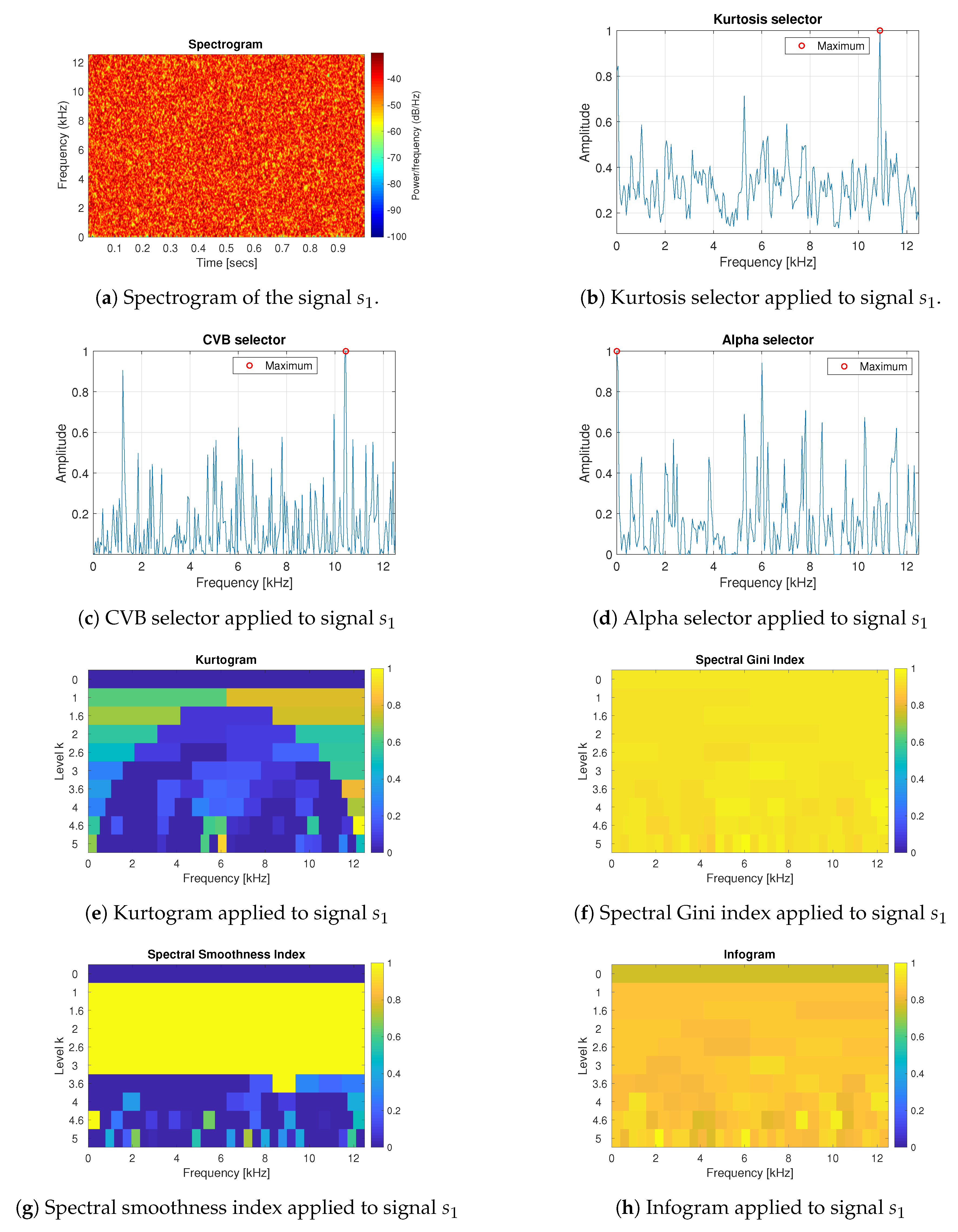
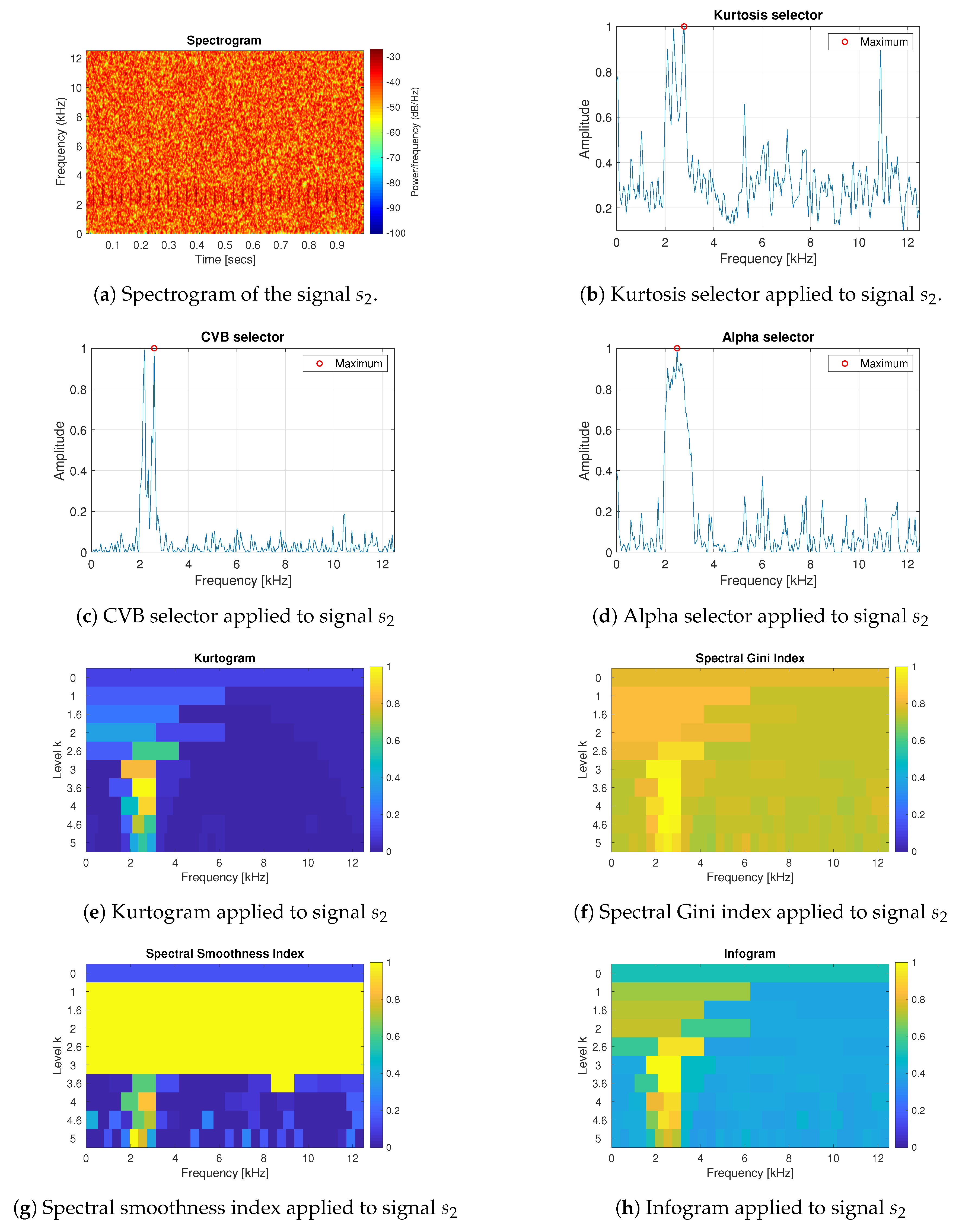

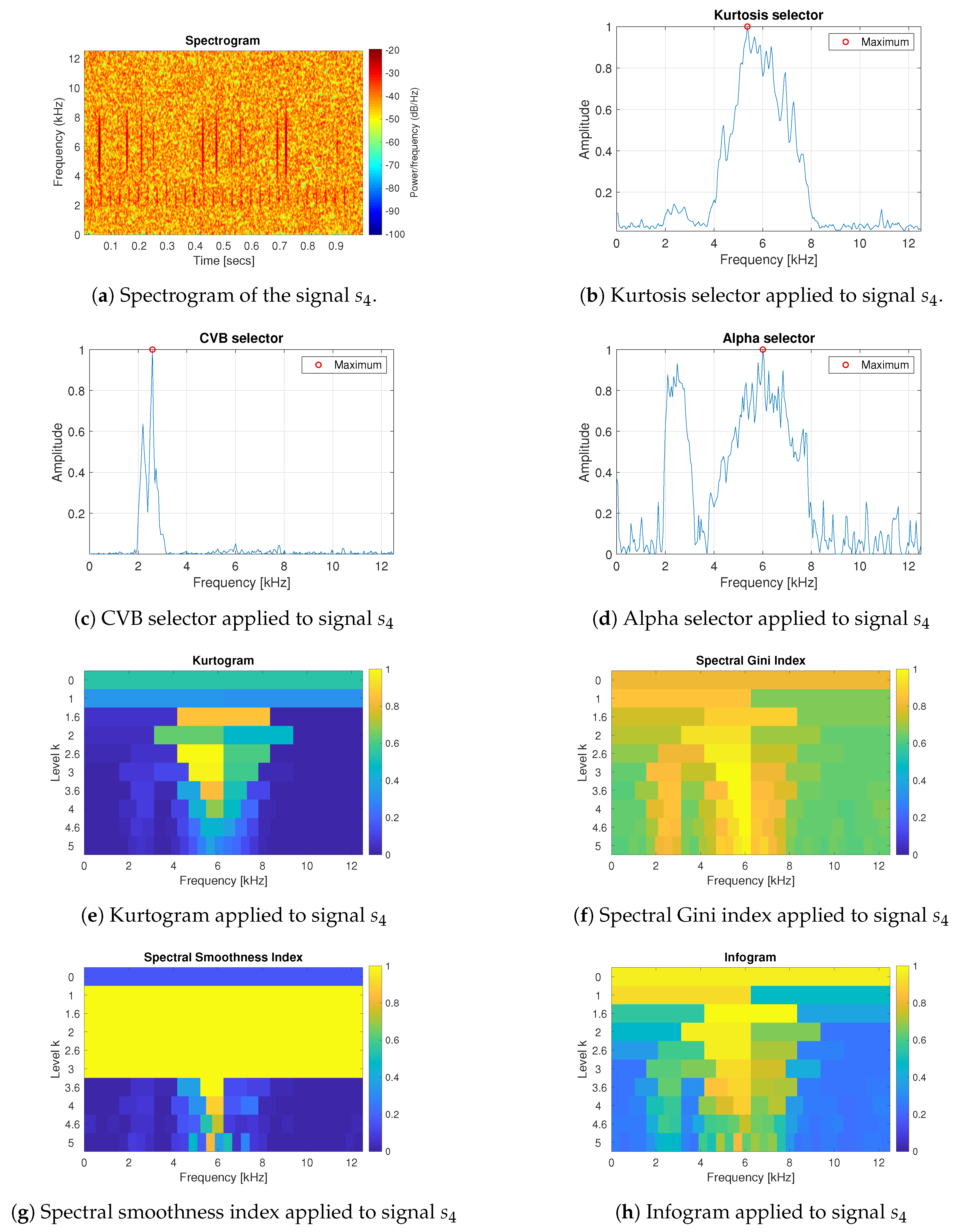
References
- Antoni, J.; Randall, R. The spectral kurtosis: Application to the vibratory surveillance and diagnostics of rotating machines. Mech. Syst. Signal Proc. 2006, 20, 308–331. [Google Scholar] [CrossRef]
- Randall, R.B.; Antoni, J.; Chobsaard, S. The relationship between spectral correlation and envelope analysis in the diagnostics of bearing faults and other cyclostationary machine signals. Mech. Syst. Signal Proc. 2001, 15, 945–962. [Google Scholar] [CrossRef]
- Barszcz, T.; Jabłoński, A. A novel method for the optimal band selection for vibration signal demodulation and comparison with the Kurtogram. Mech. Syst. Signal Proc. 2011, 25, 431–451. [Google Scholar] [CrossRef]
- Figlus, T.; Stańczyk, M. A method for detecting damage to rolling bearings in toothed gears of processing lines. Metalurgija 2016, 55, 75–78. [Google Scholar]
- Yang, Y.; Dong, X.; Peng, Z.; Zhang, W.; Meng, G. Vibration signal analysis using parameterized time–frequency method for features extraction of varying-speed rotary machinery. J. Sound Vib. 2015, 335, 350–366. [Google Scholar] [CrossRef]
- Abboud, D.; Antoni, J.; Sieg-Zieba, S.; Eltabach, M. Envelope analysis of rotating machine vibrations in variable speed conditions: A comprehensive treatment. Mech. Syst. Signal Proc. 2017, 84, 200–226. [Google Scholar] [CrossRef]
- Borghesani, P.; Shahriar, M.R. Cyclostationary analysis with logarithmic variance stabilisation. Mech. Syst. Signal Proc. 2016, 70, 51–72. [Google Scholar] [CrossRef]
- Smith, W.A.; Borghesani, P.; Ni, Q.; Wang, K.; Peng, Z. Optimal demodulation-band selection for envelope-based diagnostics: A comparative study of traditional and novel tools. Mech. Syst. Signal Proc. 2019, 134, 106303. [Google Scholar] [CrossRef]
- Borghesani, P.; Antoni, J. CS2 analysis in presence of non-Gaussian background noise–Effect on traditional estimators and resilience of log-envelope indicators. Mech. Syst. Signal Proc. 2017, 90, 378–398. [Google Scholar] [CrossRef]
- Lei, Y.; Lin, J.; He, Z.; Zuo, M.J. A review on empirical mode decomposition in fault diagnosis of rotating machinery. Mech. Syst. Signal Proc. 2013, 35, 108–126. [Google Scholar] [CrossRef]
- Dybała, J.; Zimroz, R. Rolling bearing diagnosing method based on empirical mode decomposition of machine vibration signal. Appl. Acoust. 2014, 77, 195–203. [Google Scholar] [CrossRef]
- Peng, Z.; Chu, F. Application of the wavelet transform in machine condition monitoring and fault diagnostics: A review with bibliography. Mech. Syst. Signal Proc. 2004, 18, 199–221. [Google Scholar] [CrossRef]
- Yan, R.; Gao, R.X.; Chen, X. Wavelets for fault diagnosis of rotary machines: A review with applications. Signal Proc. 2014, 96, 1–15. [Google Scholar] [CrossRef]
- Figlus, T.; Liščák, Š.; Wilk, A.; Łazarz, B. Condition monitoring of engine timing system by using wavelet packet decomposition of a acoustic signal. J. Mech. Sci. Technol. 2014, 28, 1663–1671. [Google Scholar] [CrossRef]
- Combet, F.; Gelman, L. Optimal filtering of gear signals for early damage detection based on the spectral kurtosis. Mech. Syst. Signal Proc. 2009, 23, 652–668. [Google Scholar] [CrossRef]
- Wodecki, J.; Michalak, A.; Zimroz, R. Optimal filter design with progressive genetic algorithm for local damage detection in rolling bearings. Mech. Syst. Signal Proc. 2018, 102, 102–116. [Google Scholar] [CrossRef]
- Wang, D. Some further thoughts about spectral kurtosis, spectral L2/L1 norm, spectral smoothness index and spectral Gini index for characterizing repetitive transients. Mech. Syst. Signal Proc. 2018, 108, 360–368. [Google Scholar] [CrossRef]
- Randall, R.B.; Antoni, J. Rolling element bearing diagnostics—A tutorial. Mech. Syst. Signal Proc. 2011, 25, 485–520. [Google Scholar] [CrossRef]
- Antoni, J. Fast computation of the kurtogram for the detection of transient faults. Mech. Syst. Signal Proc. 2007, 21, 108–124. [Google Scholar] [CrossRef]
- Obuchowski, J.; Wyłomańska, A.; Zimroz, R. Selection of informative frequency band in local damage detection in rotating machinery. Mech. Syst. Signal Proc. 2014, 48, 138–152. [Google Scholar] [CrossRef]
- Wodecki, J.; Kruczek, P.; Bartkowiak, A.; Zimroz, R.; Wyłomańska, A. Novel method of informative frequency band selection for vibration signal using Nonnegative Matrix Factorization of spectrogram matrix. Mech. Syst. Signal Proc. 2019, 130, 585–596. [Google Scholar] [CrossRef]
- Chaari, F.; Leskow, J.; Napolitane, A.; Zimroz, R.; Wylomanska, A. Cyclostationarity: Theory and Methods–IV; Springer: Berlin/Heidelberg, Germany, 2020. [Google Scholar]
- Lundén, J.; Kassam, S.A.; Koivunen, V. Robust nonparametric cyclic correlation-based spectrum sensing for cognitive radio. IEEE Trans. Signal Proc. 2009, 58, 38–52. [Google Scholar] [CrossRef]
- Girondin, V.; Pekpe, K.M.; Morel, H.; Cassar, J.P. Bearings fault detection in helicopters using frequency readjustment and cyclostationary analysis. Mech. Syst. Signal Proc. 2013, 38, 499–514. [Google Scholar] [CrossRef]
- Napolitano, A. Cyclostationarity: New trends and applications. Signal Proc. 2016, 120, 385–408. [Google Scholar] [CrossRef]
- Antoni, J. Cyclostationarity by examples. Mech. Syst. Signal Proc. 2009, 23, 987–1036. [Google Scholar] [CrossRef]
- Kruczek, P.; Zimroz, R.; Wyłomańska, A. How to detect the cyclostationarity in heavy-tailed distributed signals. Signal Proc. 2020, 107514. [Google Scholar] [CrossRef]
- Liu, Y.; Wu, Q.; Zhang, Y.; Gao, J.; Qiu, T. Cyclostationarity-based DOA estimation algorithms for coherent signals in impulsive noise environments. EURASIP J. Wirel. Commun. Netw. 2019, 2019, 81. [Google Scholar] [CrossRef]
- Gelli, G.; Izzo, L.; Paura, L. Cyclostationarity-based signal detection and source location in non-Gaussian noise. IEEE Trans. Commun. 1996, 44, 368–376. [Google Scholar] [CrossRef]
- Satija, U.; Mohanty, M.; Ramkumar, B. Cyclostationary features based modulation classification in presence of non Gaussian noise using sparse signal decomposition. Wireless Pers. Commun. 2017, 96, 5723–5741. [Google Scholar] [CrossRef]
- Liu, Y.; Qiu, T.; Sheng, H. Time-difference-of-arrival estimation algorithms for cyclostationary signals in impulsive noise. Signal Proc. 2012, 92, 2238–2247. [Google Scholar] [CrossRef]
- Chen, Z.; Yang, Y.; Hu, Z.; Shen, G. Detecting and predicting early faults of complex rotating machinery based on cyclostationary time series model. Vib. Acoust. 2006, 128. [Google Scholar] [CrossRef]
- Zhao, X.; Qin, Y.; He, C.; Jia, L.; Kou, L. Rolling element bearing fault diagnosis under impulsive noise environment based on cyclic correntropy spectrum. Entropy 2019, 21, 50. [Google Scholar] [CrossRef]
- Biedka, T.E.; Mili, L.; Reed, J.H. Robust estimation of cyclic correlation in contaminated Gaussian noise. In Conference Record of the Twenty-Ninth Asilomar Conference on Signals, Systems and Computers; IEEE: Piscataway, NJ, USA, 1996; Volume 1, pp. 511–515. [Google Scholar]
- Ma, X.; Nikias, C.L. Joint estimation of time delay and frequency delay in impulsive noise using fractional lower order statistics. IEEE Trans. Signal Proc. 1996, 44, 2669–2687. [Google Scholar]
- Yu, G.; Li, C.; Zhang, J. A new statistical modeling and detection method for rolling element bearing faults based on alpha–stable distribution. Mech. Syst. Signal Proc. 2013, 41, 155–175. [Google Scholar] [CrossRef]
- Katkovnik, V. Robust M-periodogram. IEEE Trans. Signal Proc. 1998, 46, 3104–3109. [Google Scholar] [CrossRef]
- Jeon, J.H.; Kim, Y.H. Localization of moving periodic impulsive source in a noisy environment. Mech. Syst. Signal Proc. 2008, 22, 753–759. [Google Scholar] [CrossRef]
- Salehzadeh, N.A.; Ferri, A.M. Vibration-Based Techniques For Damage Detection And Localization In Engineering Structures; World Scientific: Singapore, 2018; Volume 10. [Google Scholar]
- Liu, R.; Yang, B.; Zio, E.; Chen, X. Artificial intelligence for fault diagnosis of rotating machinery: A review. Mech. Syst. Signal Proc. 2018, 108, 33–47. [Google Scholar] [CrossRef]
- Zhao, Y.; Li, T.; Zhang, X.; Zhang, C. Artificial intelligence-based fault detection and diagnosis methods for building energy systems: Advantages, challenges and the future. Renew. Sustain. Energy Rev. 2019, 109, 85–101. [Google Scholar] [CrossRef]
- Wylomanska, A.; Zimroz, R.; Janczura, J.; Obuchowski, J. Impulsive Noise Cancellation Method for Copper Ore Crusher Vibration Signals Enhancement. IEEE Trans. Ind. Electron. 2016, 63, 5612–5621. [Google Scholar] [CrossRef]
- Wodecki, J.; Michalak, A.; Zimroz, R.; Barszcz, T.; Wyłomańska, A. Impulsive source separation using combination of Nonnegative Matrix Factorization of bi-frequency map, spatial denoising and Monte Carlo simulation. Mech. Syst. Signal Proc. 2019, 127, 89–101. [Google Scholar] [CrossRef]
- Wyłomańska, A.; Żak, G.; Kruczek, P.; Zimroz, R. Application of tempered stable distribution for selection of optimal frequency band in gearbox local damage detection. Appl. Acoust. 2017, 128, 14–22. [Google Scholar] [CrossRef]
- Antoni, J. The spectral kurtosis: A useful tool for characterising non-stationary signals. Mech. Syst. Signal Proc. 2006, 20, 282–307. [Google Scholar] [CrossRef]
- Żak, G.; Wyłomańska, A.; Zimroz, R. Application of alpha-stable distribution approach for local damage detection in rotating machines. J. Vibroeng. 2015, 17, 2987–3002. [Google Scholar]
- Miao, Y.; Zhao, M.; Lin, J. Improvement of kurtosis-guided-grams via Gini index for bearing fault feature identification. Meas. Sci. Technol. 2017, 28, 125001. [Google Scholar] [CrossRef]
- Antoni, J. The infogram: Entropic evidence of the signature of repetitive transients. Mech. Syst. Signal Proc. 2016, 74, 73–94. [Google Scholar] [CrossRef]
- Hebda-Sobkowicz, J.; Zimroz, R.; Pitera, M.; Wylomanska, A. Informative frequency band selection in the presence of non-Gaussian noise—A novel approach based on the conditional variance statistic. Mech. Syst. Signal Proc. 2020. submitted. [Google Scholar]
- Westfall, P.H. Kurtosis as peakedness, 1905–2014. R.I.P. Am Stat. 2014, 68, 191–195. [Google Scholar] [CrossRef]
- Joanes, D.; Gill, C. Comparing measures of sample skewness and kurtosis. J. R Stat. Soc. Ser. D Stat. 1998, 47, 183–189. [Google Scholar] [CrossRef]
- Dyer, D.; Stewart, R. Detection of rolling element bearing damage by statistical vibration analysis. J. Mech. Des. 1978, 100, 229–235. [Google Scholar] [CrossRef]
- Feng, Z.; Liang, M.; Chu, F. Recent advances in time–frequency analysis methods for machinery fault diagnosis: A review with application examples. Mech. Syst. Signal Proc. 2013, 38, 165–205. [Google Scholar] [CrossRef]
- Żak, G.; Teuerle, M.; Wyłomańska, A.; Zimroz, R. Measures of dependence for-stable distributed processes and its application to diagnostics of local damage in presence of impulsive noise. Shock Vib. 2017, 2017. [Google Scholar] [CrossRef]
- Pachaud, C.; Salvetat, R.; Fray, C. Crest factor and kurtosis contributions to identify defects inducing periodical impulsive forces. Mech. Syst. Signal Proc. 1997, 11, 903–916. [Google Scholar] [CrossRef]
- Samoradnitsky, G. Stable Non-Gaussian Random Processes: Stochastic Models with Infinite Variance; Chapman & Hall: Boca Raton, FL, USA, 1994. [Google Scholar]
- McCulloch, J.H. Simple consistent estimators of stable distribution parameters. Commun. Stat. Simul. Comput. 1986, 15, 1109–1136. [Google Scholar] [CrossRef]
- Żak, G.; Wyłomańska, A.; Zimroz, R. Data-driven vibration signal filtering procedure based on the α-stable distribution. J. Vibroeng. 2016, 18. [Google Scholar]
- Gini, C. Measurement of inequality of incomes. Econ. J. 1921, 31, 124–126. [Google Scholar] [CrossRef]
- Loza, C.A.; Principe, J.C. Transient model of EEG using Gini Index-based matching pursuit. In 2016 IEEE International Conference on Acoustics, Speech and Signal Processing (ICASSP); IEEE: Piscataway, NJ, USA, 2016; pp. 724–728. [Google Scholar]
- Wang, Y.; Yang, L.; Xiang, J.; Yang, J.; He, S. A hybrid approach to fault diagnosis of roller bearings under variable speed conditions. Meas. Sci. Technol. 2017, 28, 125104. [Google Scholar] [CrossRef]
- Hurley, N.; Rickard, S. Comparing measures of sparsity. IEEE Trans. Inf. Theory 2009, 55, 4723–4741. [Google Scholar] [CrossRef]
- Bozchalooi, I.S.; Liang, M. A smoothness index-guided approach to wavelet parameter selection in signal de-noising and fault detection. J. Sound Vib. 2007, 308, 246–267. [Google Scholar] [CrossRef]
- Jaworski, P.; Pitera, M. THE 20-60-20 RULE. Discrete Cont. Dyn. Syst. Ser. B 2016, 21. [Google Scholar] [CrossRef]
- Jelito, D.; Pitera, M. Newfat-tail normality test based on conditional second moments with applications to finance. arXiv 2018, arXiv:1811.05464. [Google Scholar]
- Brillouin, L. Science and Information Theory; Courier Corporation: Chelmsford, MA, USA, 2013. [Google Scholar]
- Perthame, B. Boltzmann type schemes for gas dynamics and the entropy property. SIAM J. Num. Anal. 1990, 27, 1405–1421. [Google Scholar] [CrossRef]
- Li, C.; Cabrera, D.; de Oliveira, J.V.; Sanchez, R.V.; Cerrada, M.; Zurita, G. Extracting repetitive transients for rotating machinery diagnosis using multiscale clustered grey infogram. Mech. Syst. Signal Proc. 2016, 76, 157–173. [Google Scholar] [CrossRef]

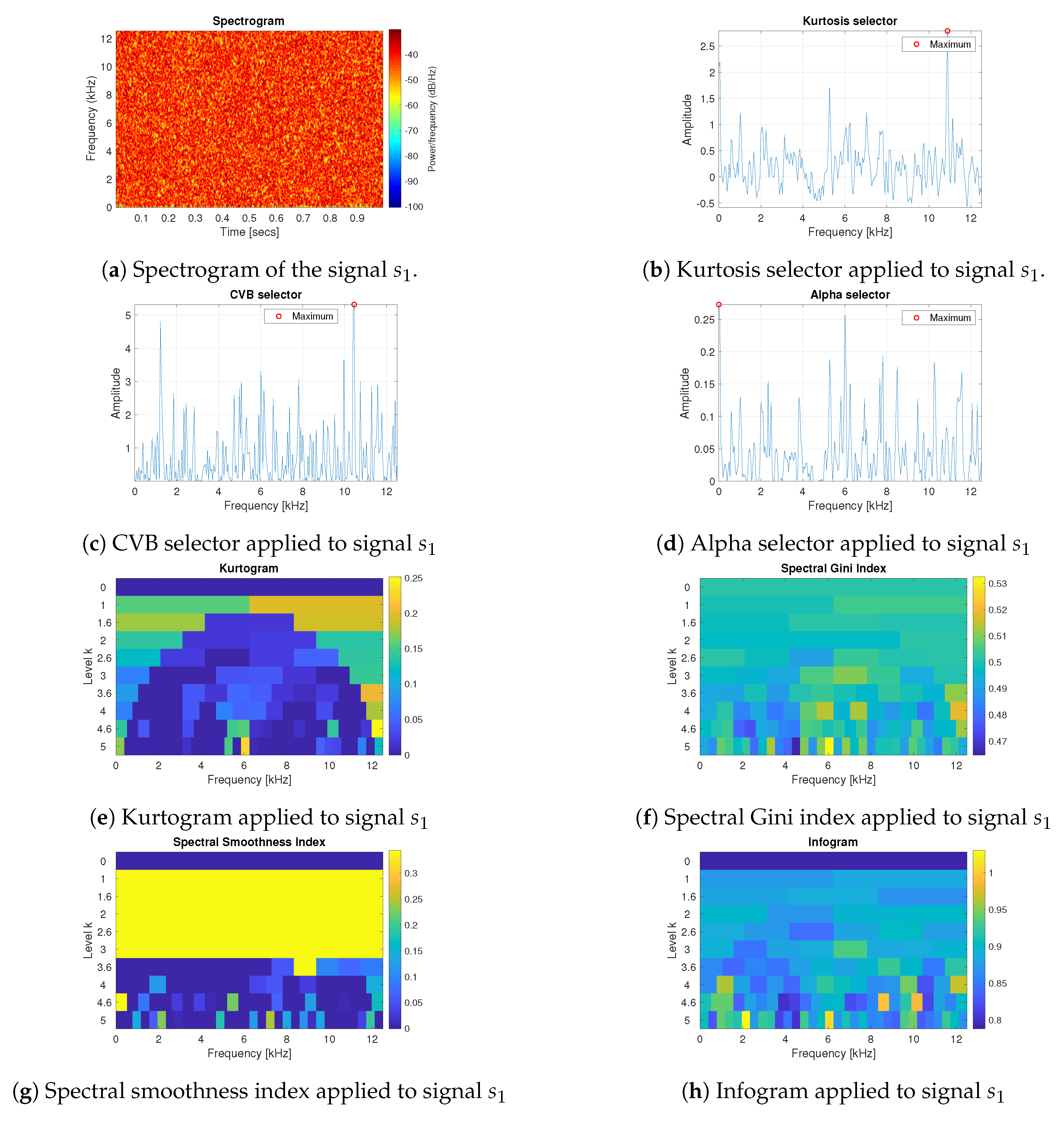
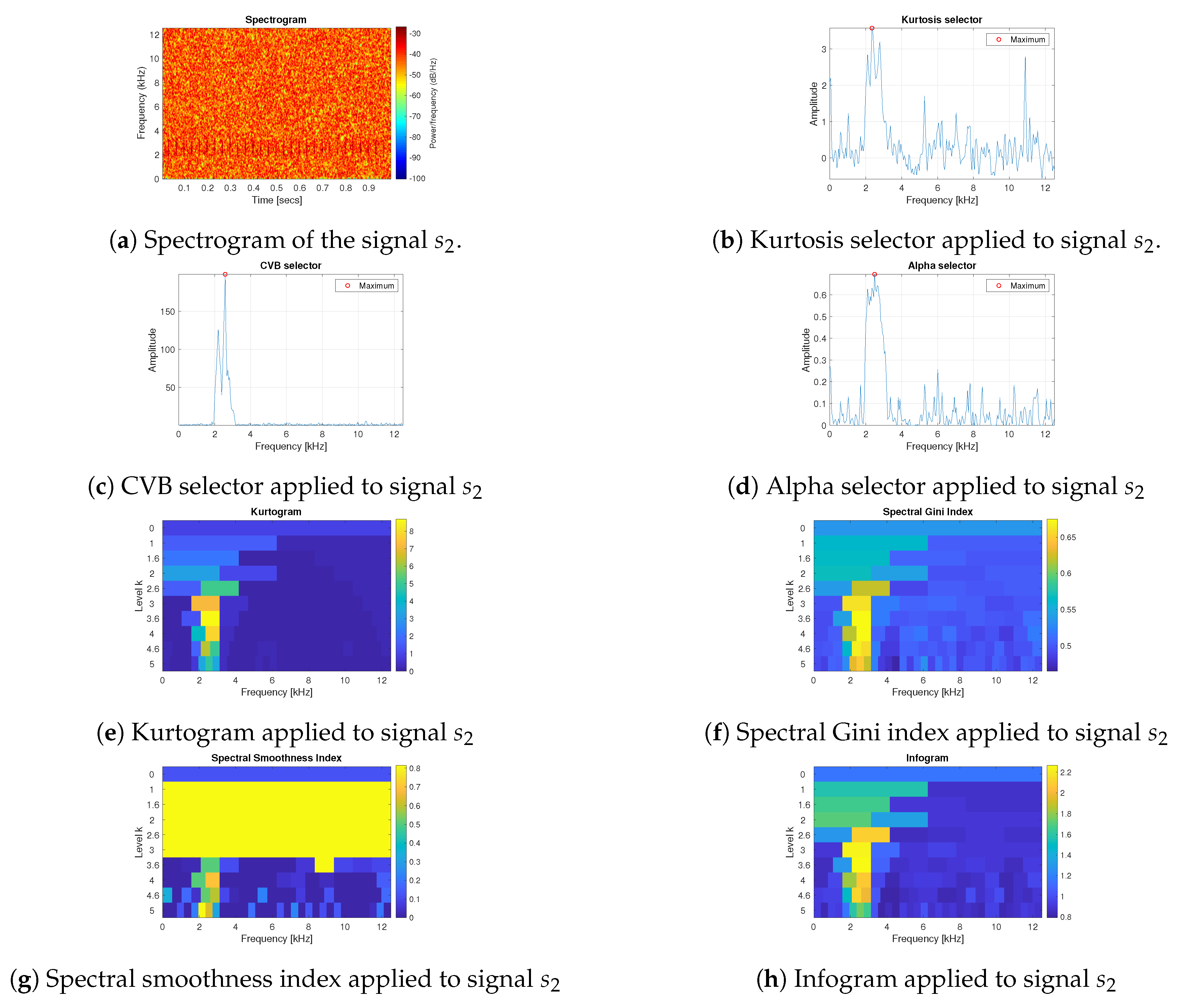
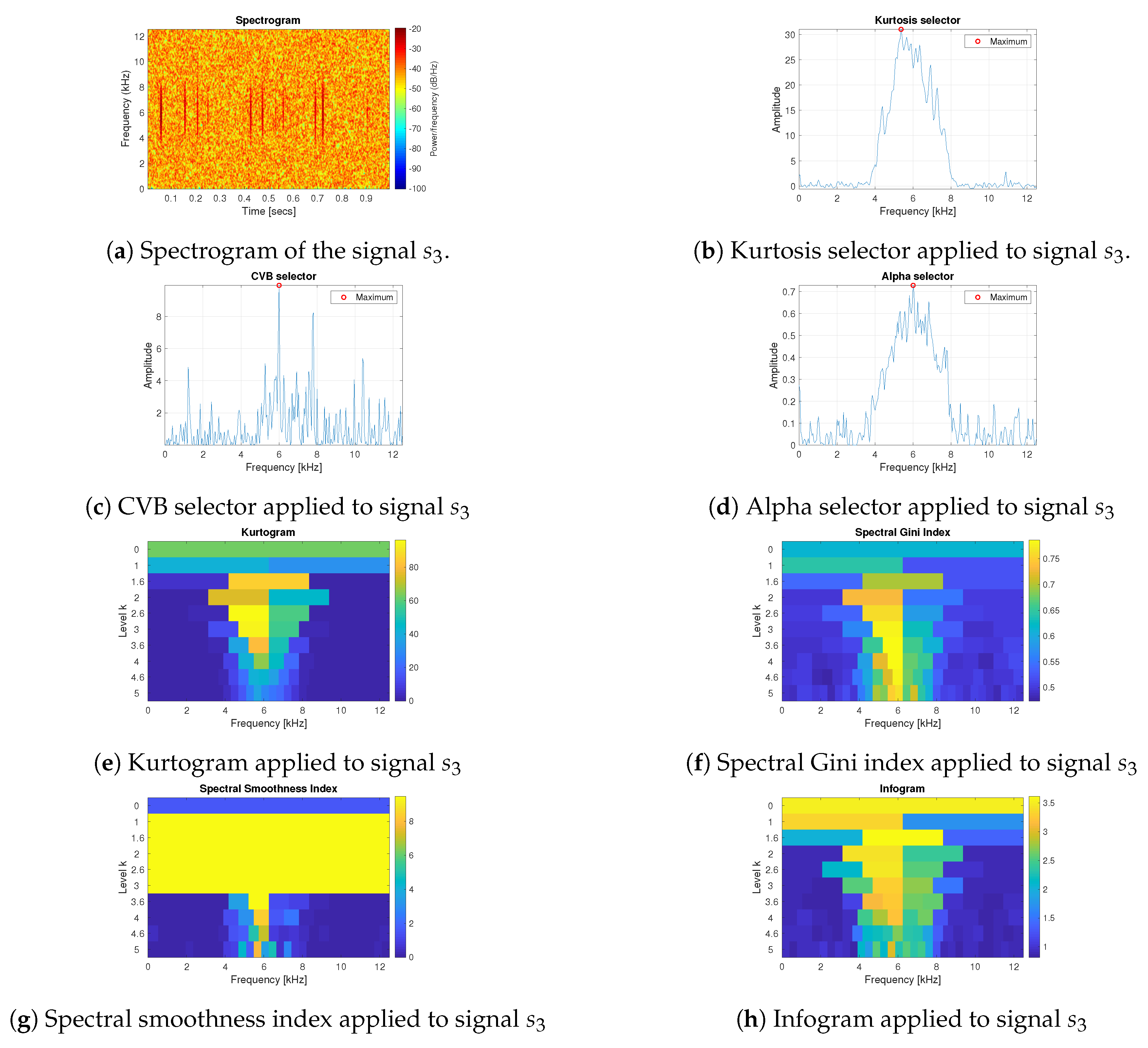
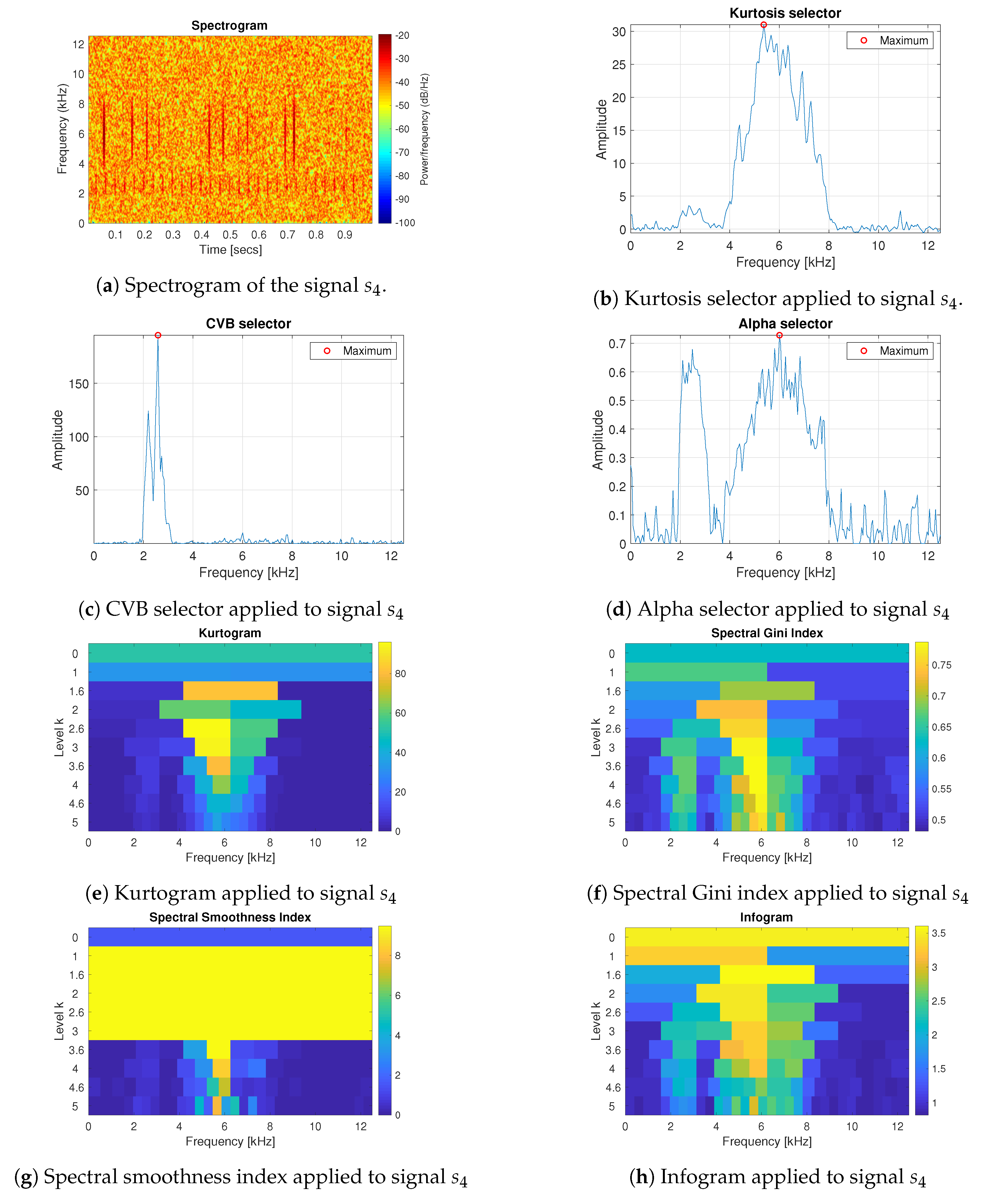
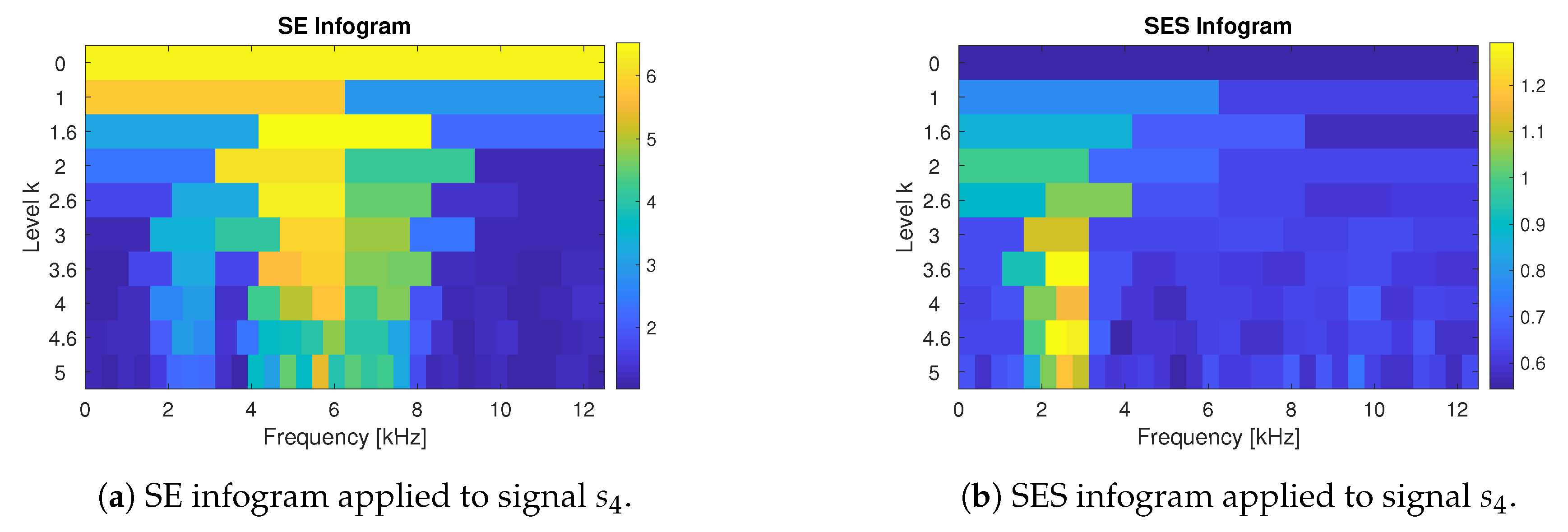

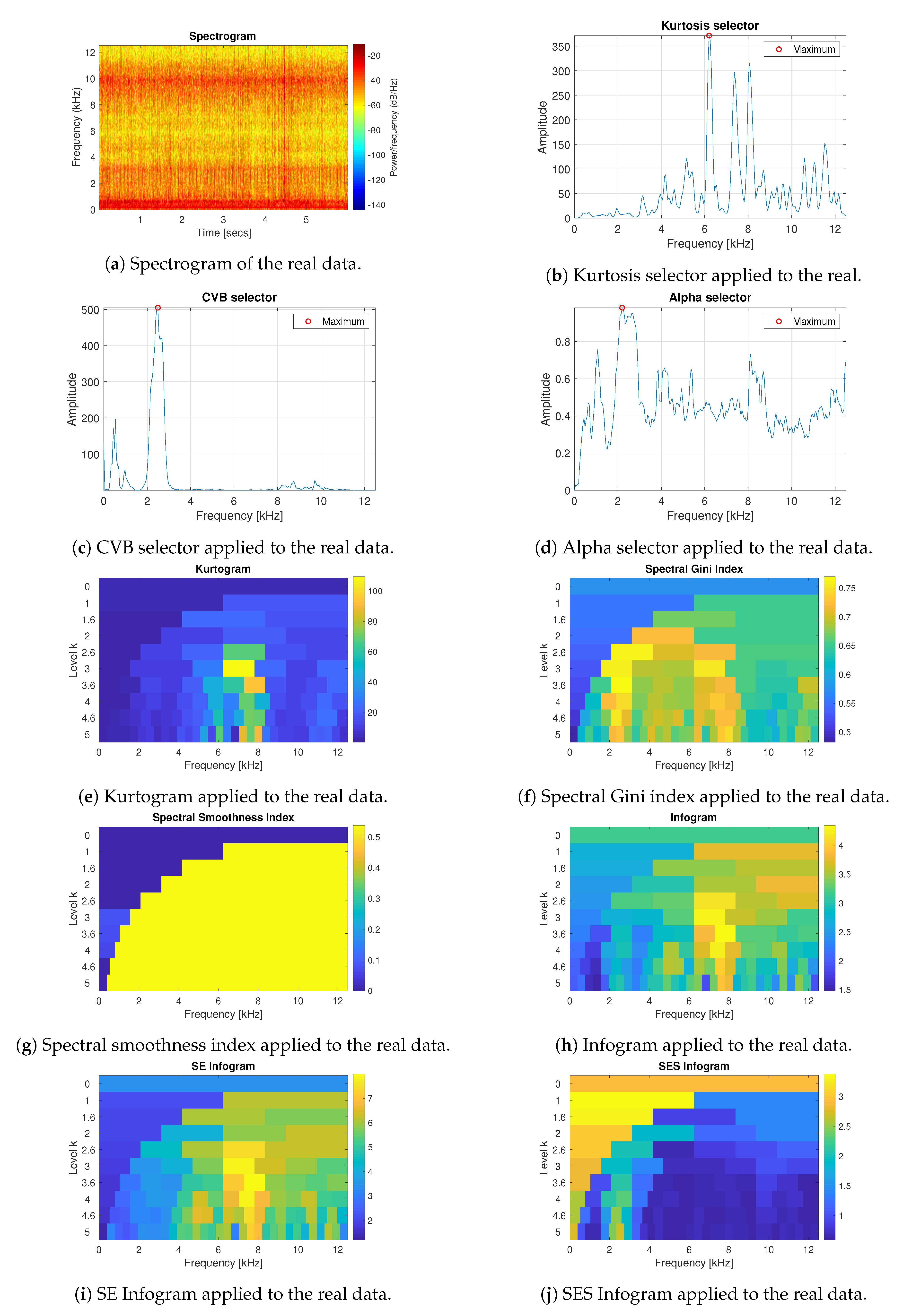
© 2020 by the authors. Licensee MDPI, Basel, Switzerland. This article is an open access article distributed under the terms and conditions of the Creative Commons Attribution (CC BY) license (http://creativecommons.org/licenses/by/4.0/).
Share and Cite
Hebda-Sobkowicz, J.; Zimroz, R.; Wyłomańska, A. Selection of the Informative Frequency Band in a Bearing Fault Diagnosis in the Presence of Non-Gaussian Noise—Comparison of Recently Developed Methods. Appl. Sci. 2020, 10, 2657. https://doi.org/10.3390/app10082657
Hebda-Sobkowicz J, Zimroz R, Wyłomańska A. Selection of the Informative Frequency Band in a Bearing Fault Diagnosis in the Presence of Non-Gaussian Noise—Comparison of Recently Developed Methods. Applied Sciences. 2020; 10(8):2657. https://doi.org/10.3390/app10082657
Chicago/Turabian StyleHebda-Sobkowicz, Justyna, Radosław Zimroz, and Agnieszka Wyłomańska. 2020. "Selection of the Informative Frequency Band in a Bearing Fault Diagnosis in the Presence of Non-Gaussian Noise—Comparison of Recently Developed Methods" Applied Sciences 10, no. 8: 2657. https://doi.org/10.3390/app10082657
APA StyleHebda-Sobkowicz, J., Zimroz, R., & Wyłomańska, A. (2020). Selection of the Informative Frequency Band in a Bearing Fault Diagnosis in the Presence of Non-Gaussian Noise—Comparison of Recently Developed Methods. Applied Sciences, 10(8), 2657. https://doi.org/10.3390/app10082657





